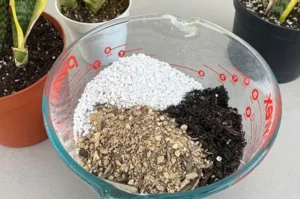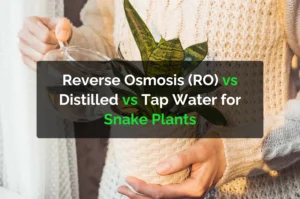Snake plants, also known as Sansevieria or Dracaena trifasciata, are known for their hardiness and ability to survive in tough conditions. However, while they tolerate neglect, cold temperatures are a different story. If you’re wondering how low is too low for your snake plant, this article will guide you through the ideal temperature range, cold damage signs, and how to protect your plant from winter chills.
Ideal Temperature Range for Snake Plants
Snake plants thrive in temperatures between 60°F to 85°F (15°C to 29°C). These tropical natives are accustomed to warm climates, so they prefer stable indoor temperatures. While they can survive brief exposure to slightly cooler temperatures, anything below 50°F (10°C) can be harmful.
USDA Hardiness Zones
Snake plants are best suited for USDA Zones 9–11 if grown outdoors. In colder regions, they should be treated as indoor houseplants, especially during fall and winter months.
What Temperature Is Too Cold?
Temperatures below 40°F (4.5°C) are considered too cold for snake plants. Extended exposure to such low temperatures may cause leaf damage, wilting, or root rot. In freezing conditions (32°F (0°C) or lower) snake plants can suffer irreversible frost damage.
Here’s a quick reference:
| Temperature | Effect on Snake Plant |
| Above 60°F | Ideal and healthy |
| 50–60°F | Tolerable, but not ideal |
| 40–50°F | Risk of cold stress |
| Below 40°F | Dangerous, risk of damage |
| 32°F and below | Frostbite and death likely |
Signs of Cold Damage in Snake Plants
Snake plants react visibly when exposed to cold temperatures. Watch for these warning signs:
- Mushy, soft leaves: A sign of frozen tissue.
- Yellowing leaves: Caused by cold stress or water imbalance.
- Drooping or curling leaves: A common symptom of cold shock.
- Brown spots or lesions: Tissue damage from freezing conditions.
- Slow or no growth: If temperatures drop, growth halts completely.
If your snake plant shows these symptoms, move it to a warmer spot and prune any dead or damaged leaves.
How to Protect Snake Plants from Cold Weather
Whether you keep your snake plant indoors or outdoors, proper care during cold seasons can prevent damage.
1. Bring Outdoor Plants Inside
If you live in a climate where winters drop below 50°F, bring your snake plant indoors before the first frost. Place it near a bright window, but away from cold drafts.
2. Avoid Cold Windows and Drafts
Even indoors, placing your snake plant too close to an icy window or door can harm it. Make sure it stays in a warm, draft-free area.
3. Reduce Watering in Winter
In colder temperatures, snake plants go into dormancy. Overwatering during this time can cause root rot. Water sparingly only when the soil is completely dry.
4. Use Insulated Pots
If your plant must stay near a window or colder area, consider using a ceramic or insulated pot to help retain warmth in the root zone.
5. Provide Supplemental Heat
In extremely cold regions, you can place your snake plant near a heat source like a space heater or use a heat mat. However, don’t place it too close, as direct heat can dry out the leaves.
Best Indoor Locations for Winter
Here are a few spots that work well for snake plants during winter:
- South or west-facing windows
- Rooms with stable temperature (living room, bedroom)
- Areas away from radiators, fireplaces, or unsealed windows
Can Snake Plants Survive Frost?
Unfortunately, no. Snake plants are not frost-hardy. When temperatures reach the freezing point (32°F or 0°C), the water inside the plant’s cells freezes, causing the tissues to rupture. This leads to irreversible damage and often plant death. If frost is in the forecast, always move your plant indoors.
Frequently Asked Questions (FAQs):
Can snake plants survive in a garage during winter?
Only if the garage stays above 50°F (10°C). Many garages drop below that temperature, especially overnight, so it’s best to move your plant to a warmer location indoors.
What should I do if my snake plant froze?
Move the plant to a warmer place immediately. Cut off any mushy or damaged leaves. Do not water it until the soil is fully dry and monitor it closely for signs of recovery.
Is it okay to keep snake plants outside in fall?
Yes, as long as the temperatures remain above 50°F. Once nights start getting cooler, it’s time to move them indoors.
Can I use a heat lamp for my snake plant in winter?
Yes, but make sure the heat lamp is not too close. A gentle, consistent warmth works best. Avoid drying out the plant or soil too much.
How do I know if my home is too cold for my snake plant?
If your indoor temperatures fall below 50°F regularly, especially at night, it’s too cold. A thermometer can help you monitor the room’s temperature.
Conclusion
Snake plants are tough, but they aren’t built to withstand the cold. Temperatures below 50°F (10°C) put your plant at risk, and anything below 40°F (4.5°C) can cause serious harm. If you want your Sansevieria to stay healthy all year round, keep it warm, dry, and safe from drafts. With the right care, your snake plant will continue to brighten your space no matter the season.






